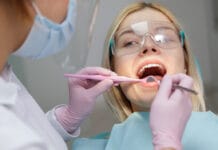Disclosure: This quiz is sponsored content from DenMat as part of our sponsored partner program.
Let's test your powered toothbrush knowledge!
While brushing the teeth of a geriatric person in a long-term care facility, caregivers prefer to use a manual toothbrush rather than a powered toothbrush.
When given a choice, caregivers routinely prefer using a powered toothbrush to provide care to elderly patients in long-term care facilities. In one study, caregivers were given access to a powered toothbrush for 15 months. A questionnaire discussing whether or not the powered toothbrushes were used and they simplified the provision of care was given to each caregiver. Results indicated that 78% of respondents always or frequently used the powered brush and 63% claimed oral care procedures were simplified after the introduction of a powered toothbrush.1
1. Wolden, H., Strand, G.V., Gjellestad, Å. (2006). Caregivers’ perceptions of electric versus manual toothbrushes for the institutionalised elderly. Gerodontology, 23: 106-110. doi:10.1111/j.1741-2358.2006.00114.x
How many brush strokes are sonic brush heads capable of moving per minute?
Sonic brush heads are capable of sweeping at a frequency of 31,000 brush strokes per minute. This movement allows a thorough brushing of tooth surfaces both above and below the gingival margin. Manual toothbrushes rely heavily on user technique. In comparison, rotary and sonic powered toothbrush technologies decrease the dependence on user technique and offer more thorough removal of plaque.1
1. Delaurenti, M., Ward M., Souza S., Jenkins W. (2017). The Effect of Use of a Sonic Power Toothbrush and a Manual Toothbrush Control on Plaque and Gingivitis. Journal of Clinical Dentistry, 28(Spec Iss A), A1-6.
Which of the following factors have an effect on the inflammatory process?
According to a study in the Journal of Clinical Dentistry, “The interface between a tooth, the bacteria-laden plaque that coats and surrounds its surface, and the adjacent gingivae is a site of dynamic activity.”1 This interface is a focal point of study as it is just one of a few sites in the body where the external environment is able to interact with the host. Due to overwhelming and recent research connecting inflammation in one part of the body to inflammation in other parts of the body, it is important to study the effects that lifestyle choices, dietary habits, and home oral care routine (such as using a powered toothbrush) can have on this specific interface.
1. Jenkins, W., Souza S., Ward, M., Defenbaugh, J. (2017). An Evaluation of Plaque and Gingivitis Following Home Use of Sonicare FlexCare Platinum with Premium Plaque Control Brush Head and a Manual Toothbrush. Journal of Clinical Dentistry, 28(Spec Iss A), A7-12.
Research suggests that patients who use a rotary-powered toothbrush routinely have better plaque control than those who use other homecare techniques. The Rotadent powered toothbrush is more effective in stain removal than other leading electric toothbrushes.
Research shows that the Rotadent toothbrush consistently out-performs when it comes to stain and plaque control. In a 15-year retrospective study which looked at patient compliance between manual brushing and powered brushing, 69% of rotary brush patients showed good to very good plaque control as compared to only 23% of patients who used other homecare products.1 According to an in vitro study published in the Journal of Clinical Dentistry, Rotadent excelled at removing stain from both flat and interproximal surfaces when compared to both manual and powered brushes.2
1. Bader H.I. Compliance with a rotary powered brush: a 15-year review of patient compliance. RDH. May 2011: 100 – 105.
2. Sarker, S., McLey, L., Boyd, R.L.(1997). Clinical and laboratory evaluation of powered electric toothbrushes: laboratory determination of relative interproximal cleaning efficiency of four powered toothbrushes. J Clin Dent. 1997; 8(3 Spec. No): 81 – 85
What is the correct angle a powered toothbrush should be placed at in reference to the gingival margin?
Similar to manual brushing, a powered toothbrush should be placed at a 45-degree angle to the gingival margin. This allows the bristles to reach maximum efficiency and also clean into the sulcus. Additionally, users should only apply light pressure and move the toothbrush slowly across the tooth, allowing the brush to do the work. A scrubbing motion should be avoided.












